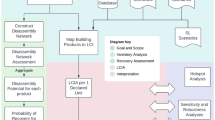Abstract
A significant durability assessment for structure design is devoted to guarantee the necessary service life for its safety and sustainability. A flexible probability assessment method here is improved based on the corrosive cracking life criterion theory model used in China and improved the design-value method mentioned in ISO2394. It first built an assessment expression consisted of design values and service life, considering limit state function and First Order Reliability Methods (FORM). Then, it took into account the uncertainties and variability about the main random variables in this assessment expression: concrete cover thickness, compressive strength and carbonation depth calculation model uncertainty factor, ignored the secondary variables with little variability. Last, by introducing and improving design-value method, it can directly calculate the service life with flexibly reliability index chosen for durability design assessment. This calculation results are easy to contrast with the target index to assess. Without traditional reliability calculation, it flexibly evaluated durability design with reliability index of safety results.
Similar content being viewed by others
References
Alexander, M. G., Ballim, Y., and Stanish, K. (2007). “A framework for use of durability indexes in performance-based design and specifications for reinforced concrete structures.” Mater Structure J. Ournal, Vol. 41, No. 5, pp. 921–936, DOI: 10.1617/s11527-007-9295-0.
Bases for design of structures-Assessment of Existing Structure (2010). ISO13822:2010.
Darmawan, M. S. and Stewart, M. G. (2015). “Effect of spatially variable pitting corrosion on structural reliability of prestressed concrete bridge girders.” Australian Journal of Structural Engineering, Vol. 6, No. 2, pp. 147–158, http://www.tandfonline.com/doi/abs/10.1080/13287982.2006.11464951.
European Committee for Standardization (2002). Basis of Structural Design, EN1990:2002, BSI, London, UK.
Gehlen, C. and Schiessl, P. (1999). “Probability-based durability design for the Western Scheldt Tunnel.” Structural Concrete, Vol. P1, No. 2, pp. 1–7.
Housing and urban-rural development of the People’s Republic of China (2008). Unified standard for reliability design of engineering structures, GB50153-2008, China Architecture and Building Press, Beijing, China (in chinese).
International Organization for Standardization (2015). International standard: General principles on reliability for structures, ISO2394: 2015, International Organization for Standardization, Geneva, Switzerland.
Joint Committee on Structural Safety (2001). Probabilistic model code: Part 1: Basis of design, Joint Committee on Structural Safety, Copenhagen, Denmark.
Kvgd, B., Snigda, R. S., and Naidu, G. T. P. (2014). “Reliability assessment of structures subjected to chloride ingress in marine environment.” International Journal of Engineering and Technical Research, IJETR, Vol. 2, No. 12, pp. 86–88, www.erpublication.org.
Liu, J. L. and Fang, Z. (2012). “Reliability-based assessment of the effect of climatic conditions and CO2 emissions on the corrosion of rc structures subjected to carbonation.” Advanced Materials Research, Vol. 503-504, pp. 780–784, DOI: 10.4028/www.scientific.net/AMR.503-504.780.
Muigai, R., Moyo, P., and Alexander, M. (2012). “Durability design of reinforced concrete structures: A comparison of the use of durability indexes in the deemed-to-satisfy approach and the full-probabilistic approach.” Materials and Structures, Vol. 45, No. 8, pp. 1233–1244, DOI: 10.1617/s11527-012-9829-y.
Niu, D. T. (2003). Durability and life forecast of reinforced concrete structure, Science Press, Beijing, China. ISBN 7-03-010793-4 (in chinese).
Ronald, O. H. S. E. (2015). “Introduction of Performance Criteria into Chapter 1 of ASCE 7-10.” Structures Congress, pp. 1432–1439, DOI: 10.1061/41171(401)125.
Yao, J. T. and Cheng, K. K. (2016). “Discussion of sensitivity factors and dominating variable for design value method.” Ksce Journal of Civil Engineering, KSCE, Vol. 72, No. 1, pp. 37–44, DOI: 10.1007/s12205-016-0232-z.
Yao, J. T., Gu, H., Zhan, Y. J., and Cheng, K. K. (2015). “The probability expression for concrete structure carbonation durability design.” Chinese Journal of Xi’an University of Architecture & Technology (Natural Science Edition), Vol. 1, pp. 1–5, DOI: 10.15986/j.1006-7930.2015.01.001 (in chinese).
Author information
Authors and Affiliations
Corresponding author
Rights and permissions
About this article
Cite this article
Yao, J., Gu, H. Durability Assessment Based on Design-value Method for Structure Design. KSCE J Civ Eng 22, 1377–1383 (2018). https://doi.org/10.1007/s12205-017-0094-z
Received:
Accepted:
Published:
Issue Date:
DOI: https://doi.org/10.1007/s12205-017-0094-z




